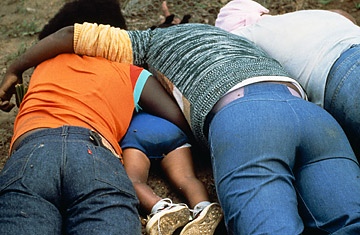
The Victims
Odell Rhodes, a Temple member who survived by hiding underneath a building, said that among the very first to line up for the poison were several mothers and their babies. He said that there was no panic or emotional outburst; that people looked as if they were "in a trance."
(7 of 8)
"The first of the bodies was a man by himself, face down, his features bloated, his torso puffed into balloon shape. Then more bodies, lying in a yard. Grotesque in their swollenness but looking relaxed as though comforted in their family togetherness. Nearly all of them were on their faces, eerie figures of slumber.
"I turned a corner, and the whole mass of bodies came into view. The smell was overpowering, the sight unworldly. There were no marks of violence, no blood. Only a few bodies showed the gruesome signs of cyanide rictus. Outside there were three dead dogs, poisoned. Down the road in a large cage was 'Mr. Muggs,' the commune's pet gorilla. He had been shot. In a tree-shaded area was Jones' home, a three-room bungalow. Bodies were scattered through all three rooms, some on beds, others on the floor. The quiet was broken only by the meowing of a cat beyond the porch."
Skip Roberts, the Guyanese assistant commissioner of crime, told Neff that the first troopers arriving in Jonestown had found Jones' house ransacked and a large safe standing both open and empty. Two of the victims in the house had been shot: one of Jones' bodyguards and Jones' mistress, Annie Moore. Most of the eight men suspected of having taken part in the airport ambush also lay dead of poisoning in the house.
The first searchers reported finding $500,000 in cash, many U.S. Treasury checks, an unspecified quantity of gold —and about 870 U.S. passports. The fact that Jones was rumored to keep some $3 million in cash at his commune raised a mystery as to whether large amounts of money were missing. The passports far exceeded the number of bodies first reported to have been found in Jonestown, promoting belief that hundreds more of the cultists had fled into the jungle.
Not until week's end did Guyanese authorities report that they had miscounted the bodies. Instead of 409, as first related, the count was about 900. U.S. embassy officials confirmed the discrepancy, attributing it at first to the finding of many children's bodies underneath the piles of others. The State Department later explained more plausibly that additional bodies had been found in outlying buildings—but failed to explain why those buildings had not been searched earlier.
As the U.S. sent large Air Force cargo planes to return the mounting numbers of American bodies to the East Coast (at a cost of some $3 million), the FBI moved into the case on the basis of a 1971 law making the assassination of a Congressman a federal crime. The FBI was also probing persistent reports by surviving members of the cult that Jones had decreed that if his community was destroyed, a "hit team" of other members would be dispatched to hunt down and kill any defectors who had turned against the cult, as well as any public officials considered guilty of harassing his group.
